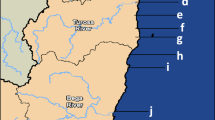Abstract.
This study presents the distribution of arsenic (As), copper (Cu), and zinc (Zn) in various seafoods—oysters (Crassostrea gigas), false fusus (Hemifuscus tuba), venus clams (Cyclina sineasis), green mussels (Perna viridis), blood clams (Arca granosa), flounders (Psettodes erumei), and rock-shells (Thais clavigera) collected from the Putai coast of the black-foot disease (BFD) area in Taiwan. Special attention is paid to evaluate the relationships among As, Cu, and Zn and effect of body size on metal concentration in Thais clavigera. Maximum Zn and Cu geometric mean (GM) concentrations (GM = 615 and 376 μg/g, dry wt, respectively) are found in oysters (Crassostrea gigas), and the values are much higher than those of the other organisms by about 1.7–208 and 1.8–375 times, respectively. Similarly, Thais clavigera has a high capacity for accumulating Cu and Zn collected from the same location. One interesting point is that relatively high As concentrations (GM = 65.7 μg/g, dry wt) in Thais clavigera are found as compared with those in other organisms (range from GM = 2.37 to 40.2 μg/g, dry wt). The As concentrations are significantly higher in Thais clavigera (1.62–27.7 times) than those in other organisms (p < 0.05), except for the false fusus (Hamifuscus tuba). A linear regression analysis shows a significant increase in Zn concentration with increasing Cu concentration in Thais clavigera. On the other hand, the As concentration is correlated with Cu and Zn concentrations (r = 0.77 and 0.77, respectively; p < 0.05) in Thais clavigera. Double logarithmic plots of metal content and concentration against dry-body weight and shell length show linear relationships. The result indicates that large individuals have higher contents of Cu, Zn and As, and have slopes of 1.58, 1.38, and 1.34, respectively. In addition, metal concentrations against shell length for all animal sizes also indicate that Cu, Zn and As have slopes of 1.92, 1.18, and 1.11, respectively. In conclusion, Thais clavigera has a high capactiy for accumulating As, Cu, and Zn and is a potential bioindicator for monitoring As, Cu and Zn.
Similar content being viewed by others
Author information
Authors and Affiliations
Additional information
Received: 8 February 1996/Revised: 15 June 1996
Rights and permissions
About this article
Cite this article
Han, B., Jeng, W., Jeng, M. et al. Rock-Shells (Thais clavigera) as an Indicator of As, Cu, and Zn Contamination on the Putai Coast of the Black-Foot Disease Area in Taiwan . Arch. Environ. Contam. Toxicol. 32, 456–461 (1997). https://doi.org/10.1007/s002449900213
Issue Date:
DOI: https://doi.org/10.1007/s002449900213




